

Jon Clements, Author (unless otherwise noted) and Editor
Current degree day accumulations
| UMass Cold Spring Orchard, Belchertown, MA |
1-June |
| Base 43 (SkyBit) | 798 |
| Base 50 (NEWA) | 544 |
| Coming events | Degree days (Base 43) |
| Spotted tentiform leafminer 1st flight subsides | 671-949 |
| Lesser apple worm 1st flight peak | 359-781 |
| Codling moth 1st flight peak | 555-983 |
| Pear psylla 1st summer adults | 737-885 |
| Black cherry fruit fly 1st catch | 702-934 |
| European red mite summer egg hatch | 737-923 |
| Obliquebanded leafroller pupae present | 601-821 |
| Obliquebanded leafroller 1st catch | 811-893 |
| Redbanded leafroller 1st flight subsides | 596-896 |
| Rose leafhopper adults on multiflora rose | 689-893 |
| Rose leafhopper adults on apple | 809-1053 |
Key insect life cycle and management dates
Note: for 2015, we have five Massachusetts orchard locations subscribed to AR: Belchertown, Groton, Phillipston, Stow and Sutton. The website for looking at AgRadar for these locations is: http://extension.umaine.edu/ipm/ag-radar-apple-sites/. What follows is for the Belchertown location.
Codling moth (CM) -- 1st generation, first sustained trap catch biofix date: May 16, Saturday. Codling moth development as of June 3: 1st adult emergence at 15% and 1st generation egg hatch at 0%. In most orchards, insecticide targetted against plum curculio and apple maggot prevent codling moth damage. If targetted codling moth control is needed, key management dates are shown here: 1st generation 3% CM egg hatch: June 17, Wednesday = target date for first spray where multiple sprays needed to control 1st generation CM. 1st generation 20% CM egg hatch: June 24, Wednesday = target date where one spray needed to control 1st generation CM.
Obliquebanded leafroller (OBLR) -- 1st generation OBLR flight begins around: June 9, Tuesday.
Oriental fruit moth (OFM) -- 1st generation OFM flight starts: May 5, Tuesday; 1st generation 55% egg hatch and first treatment date, if needed: May 26, Tuesday.
Plum curculio (PC) -- Increase risk of PC damage as McIntosh and similar cultivars increase fruit size: May 22, Friday; Earliest safe date for last PC insecticide spray: June 2, Tuesday.
San Jose scale (SJS) -- First adult SJS caught on trap: May 20, Wednesday; 1st generation SJS crawlers appear: June 19, Friday.

http://ag-radar.umext.maine.edu/MAmodel/MA-Belchertown-PCRateChart.htm
10-June, 2015 (Wednesday) Mass. Fruit Growers' Assoc. in cooperation with Essex County (MA) Fruit Growers, UNH Cooperative Extension,and UMass Extension Fruit Twilight Meeting. Parlee Farms, 95 Farwell Rd, Tyngsboro, MA. 5:30 PM.Pizza for a light supper. 1 pesticide re-certification credit. Special guest: Tom Callahan, Adams County Nursery will talk apple and peach varieties, horticulture, rootstocks, etc. Alan Eaton, UNH Cooperative Extension will discuss current pest status.
18-June, 2015 (Thursday) Fruit Twilight Meeting in cooperation with Rhode Island Fruit Growers' Assoc. Rocky Brook Orchard, 997 Wapping Rd, Middletown, RI. 5:30 PM. Bring lawn chair for yourself as there will be an outside picnic light supper. Pesticide re-certification credit(s) will be available. Special guest: George Hamilton, UNH Cooperative Extension will discuss targeted orchard spray application and demonstrate what you can do to improve your airblast spray pattern for improved pest control and pesticide efficiency.
For more information and updates, see Upcoming Events or contact Jon Clements, 413-478-7219.
Again, this is an abbreviated Healthy Fruit as I am out-of-state Tues.-Fri. It will consist of individual HF e-mail "Bites" sent out during the week of May 31, 2015. JC
Healthy Fruit "Bite" May 31, 2015 -- Dogwood borer
"Adult dogwood borer have been caught in pheromone traps at the UMass Orchard. This means adults are flying, mating, and according to AgRadar, laid eggs will start hatching app. June 25. Dogwood borer are a serious pest of dwarf apple trees, particularly those with copious burr knots and especially where the rootstock is hidden by debris, root suckers, and/or weeds. Any time now (and during the month of June) is a good time to apply Lorsban using a directed spray to the rootstock/graft union area of dwarf apple trees. (Remember, only one application of Lorsban per year is allowed in apples.) Twist-ties used for mating disruption of DB are also an option, however, I am not sure of the registration status (or availability) of those."

Healthy Fruit "Bite" June 2, 2015 -- Plum curculio
"Plum curculio (PC) were busy little buggers last week as predicted. Damage was easy to find in unprotected apple and cherry trees. (See pictures below.) We're not out of the woods quite yet, maintain some insecticide coverage to all trees or at least border rows to keep PC at bay. The NEWA PC models says we have accumulated 189 degree days Base 50 (though Monday, June 1), and we need to have 308 before the risk of having PC injury has passed. So that will be another week to 10 days depending on the weather. Keep your guard up: your insecticide options are many, however, Imidan continues to be the most effective PC spray.
"We've also noted significant feeding damage from the onslaught of green fruitworm we had pre-bloom. (See picture.) Not much to do about it now, just recognize the damage, and in years like this with warm pre-bloom weather consider applying an insecticide at pink."
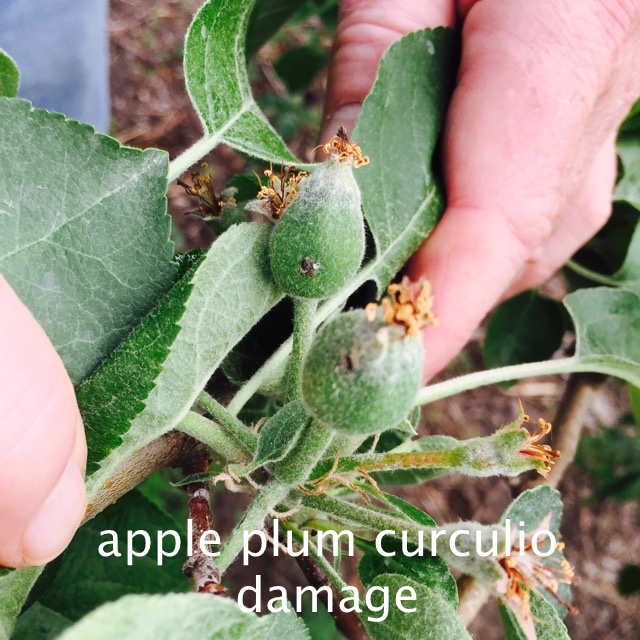
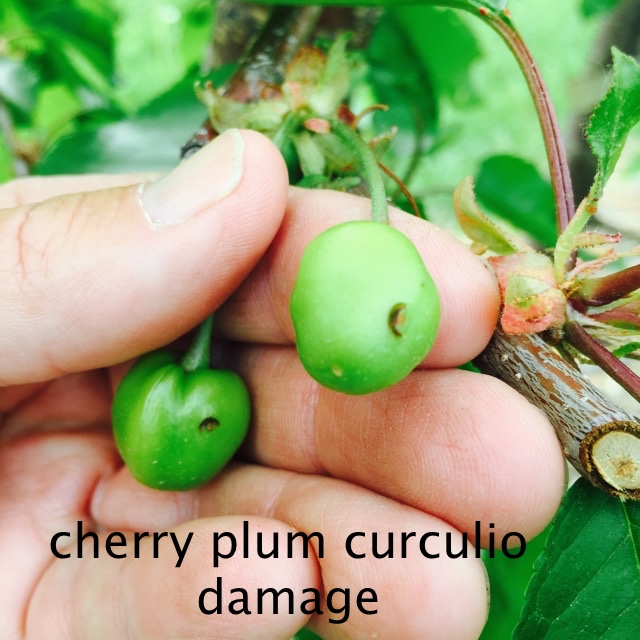
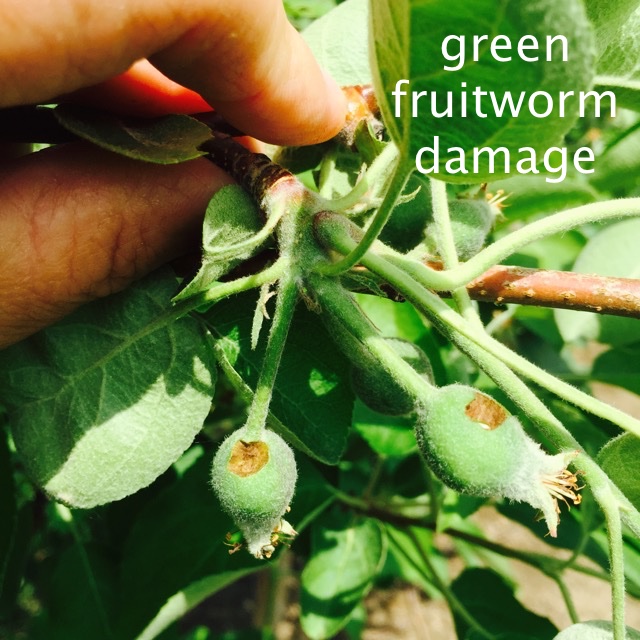
[Healthyfruit] Apple Scab Alert II - May 30
Dan Cooley
The strange weather this spring has translated to unexpected and uncertain apple disease risk evaluations, especially when it comes to apple scab ascospore maturity. As Healthy Fruit said earlier this week, in a normal year, all the apple scab ascospores would be gone by now.
Since it’s an abnormal year, the jury is still out.
If we combine the predicted rain for the next few days with these risk estimates, either there’s virtually no risk of scab infection, it will be the heaviest scab infection of the year, or something between. As I said earlier in the week, I believe the safest way to proceed is to treat the coming rainy days as potentially moderate to heavy apple scab infection(s), and spray fungicides accordingly.
Sorry for the bad news – I was out on the sprayer doing a scab treatment at CSO this morning!
[Healthyfruit] Apple Scab Update - June 2
Dan Cooley, Arthur Tuttle and Liz Garofalo
Many of you will be disappointed, but the evidence continues to tell us that while it’s well after petal fall, plenty of spores for apple scab are still around. Take a look at Liz Garofalo’s detailed report on spore maturity below. In general, the number of mature ascospores is falling off rapidly, but numbers are still high.
With spores available, it’s safest to assume the rain this week generated a scab infection. How the infection should be treated now depends on what fungicides were applied before the rain. At the UMass orchard, we’ve had 2.3 inches of rain since Sunday, May 31.
The rule of thumb for full rates of Captan, Dithane, Manzate, Penncozeb, Polyram and other protectants is that 2 inches of rain will wash protection from leaves. Sulfur is much less “rainfast”, while lime sulfur lasts better in rain. But all protectants will have been removed at some point during this rain event. Any spores released towards the end of the infection period need to be dealt with.
Systemic fungicides, including Inspire Super, Flint, Fontelis and the other fungicides listed in the table below, are absorbed into leaves and to some extent fruit, and therefore are not washed off during long rains. Flint or Sovran, or products like Luna Sensation, Pristine and Merivon, will be effective for about a week regardless of precipitation.
If you sprayed only Captan or mancozeb or both before the rain, then there’s no question that you should spray a fungicide with post-infection activity after the rain stops, probably Weds. If you applied a systemic, then it is still probably worth spraying a second application after the rain to cover any potential gaps in coverage.
There are many post-infection options. Check the table below. Keep in mind what you have already used this year, and avoid using more than two applications of fungicides in the same FRAC group if possible. For example, if you’ve already used two applications of Flint (Group 11), avoid a third, as well as Luna Sensation, Pristine and Merivon which contain Group 11 fungicides. Instead, use one of the DMI fungicides (Group 3), such as Inspire Super, Indar or Tebuzol, or Fontelis (Group 7). We recommend mixing a protectant with any of the systemic products, but don’t mix captan with Fontelis as it may damage fruit. We don’t recommend using Scala or Vangard after fruit set because the Group 9 fungicides do not have good activity against fruit scab.
The table lists estimates of post-infection activity from labels and university tests in terms of how many hours they will “reach back”. The estimates range from 1 to 4 days, depending on rates, temperature during the infection, and these days perhaps most importantly, resistance. Fungicides in Group 3 and Group 11, the DMIs and QoIs, do not completely fail all at once. Instead, they gradually lose efficacy. This may show up as less effectiveness in post-infection applications.
The post-infection activity listed is only an estimate. To maximize it, apply fungicides as soon as possible after rain stops.
Ascospore Maturity Details 6/1/15
Lab Petri plate assay: A total of 58 ascospores were seen. This is a significant drop from last week.
Lab funnel trap: Leaves from Cold Spring Orchard released 24 ascospores in this lab test, a huge drop from over 3,500 seen last week.
Lab squash mounts: All asci have matured. Of these 60% still contained mature ascospore, the remaining 40% of the asci had released their spore.
Field trap: The combined rain event beginning around 4:00pm May 31 and continuing through noon on June 1 should have released ascospores if there are spores left. We found 26 ascospores, up from the 13 we saw on May 26.
We also looked at a batch of undisturbed, overwintered leaves from a location in Greenfield using the funnel trap in the lab. This was done largely for our own amusement, as we just love counting microscopic organisms. They do add an interesting piece to the information, however, by giving us a small bit of insight as to what is happening outside of Belchertown. We saw 639 ascospores, down from last weeks 3,351 in the Greenfield leaves.
-Liz
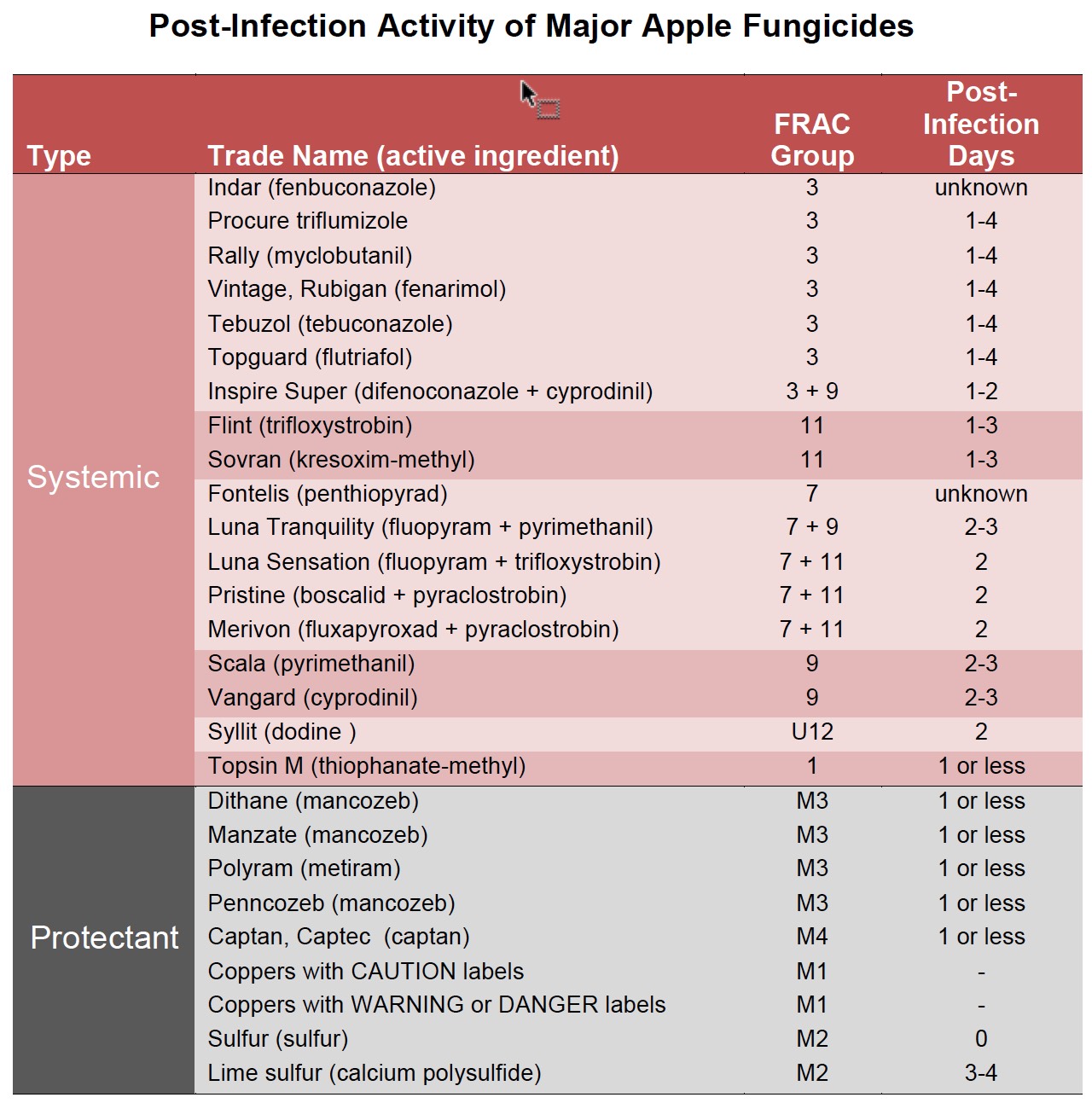
[Healthyfruit] Fire blight symptoms and samples - June 3
Fire Blight Showing
Today we had a report of fire blight in a commercial orchard and saw fire blight symptoms on unsprayed, back yard trees. It’s time to check to see if you have any blight!
If you discover blight, I would greatly appreciate it if you would let us know. Earlier in the year, Jon and I let you know that we, along with Liz Garofalo, have teamed with Dr. Quan Zeng at The Connecticut Ag. Expt. Sta. to conduct a regional survey of fire blight bacteria in New England. This project includes isolating fire blight bacteria from New England orchards, testing their resistance to streptomycin, and finding out the origin of any resistant strains if they are found. Names of the orchards will not be released, but general information on streptomycin resistance will be shared with Extension specialists, growers and consultants in our region.
To do the survey, we need to know when and where the fire blight disease outbreaks happen in Massachusetts and other New England states. Now that symptoms of fire blight are appearing, we would like your help in sampling. Please contact me or Jon if you see any fire blight in your orchard. The fresher the sample is, the better for isolation. We will come and collect the sample.
Thanks!
Dan, Liz and Jon
Dan - 413-531-3383 or dcooley@umass.edu
Liz - 413-835-1337 or ew.garofalo@gmail.com
Jon - 413-478-7219 or jon.clements@umass.edu
Healthy Fruit "Bite" June 3, 2015 -- Apple fruit thinning
"For most of you, the apple fruit thinning window is over. Hopefully you applied chemical thinners during the time as seen below where chemical thinner activity was highest and you got (or are getting) good results. You should consider measuring fruitlets to see which are growing, and which are not, giving you a better idea of final fruit set. A little more time will tell better, but it's probably too late to apply thinners now, unless you choose to do a "rescue" thinning treatment using Ethephon (Ethrel). See: http://extension.umass.edu/fruitadvisor/sites/fruitadvisor/files/fact-sheets/pdf/F-129.pdf."
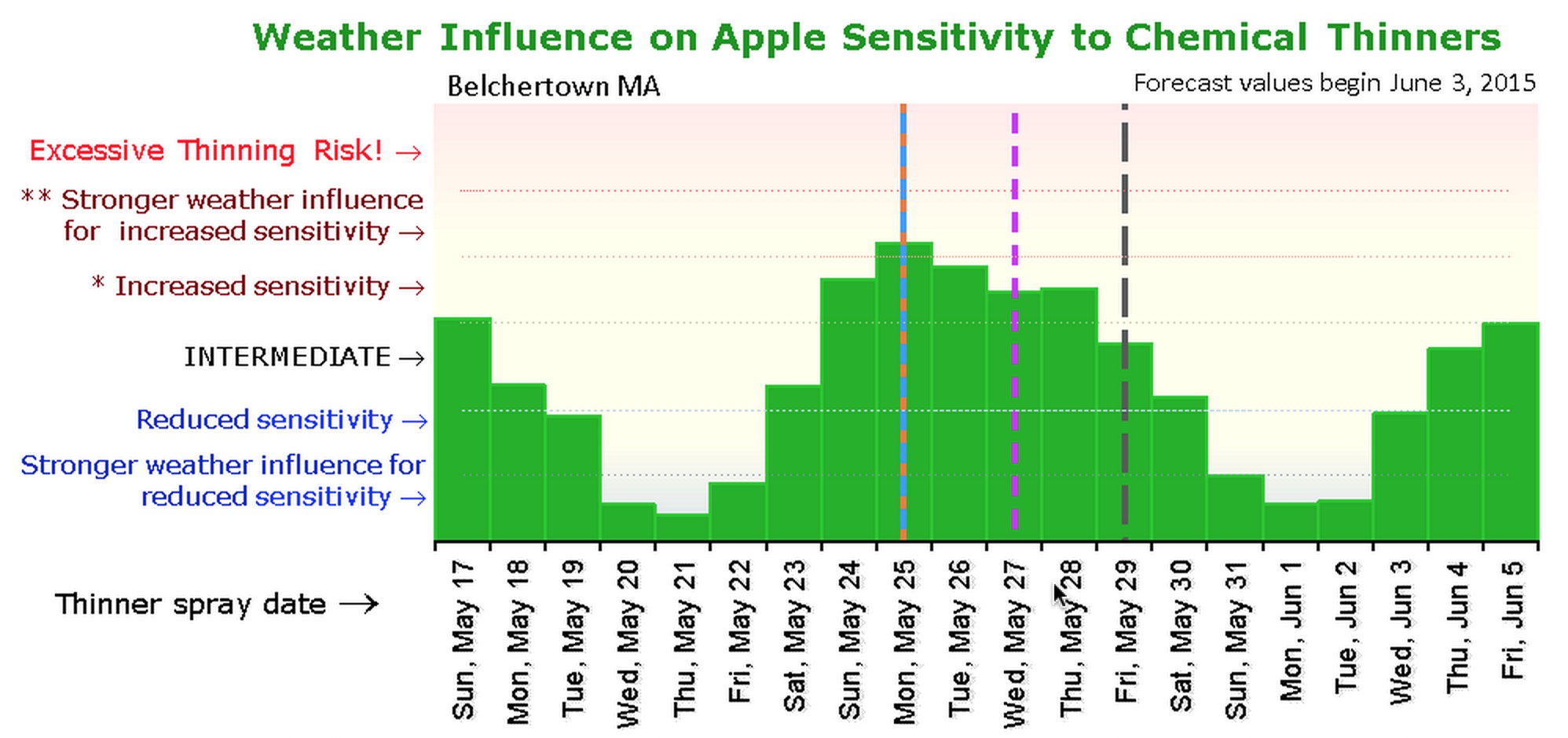
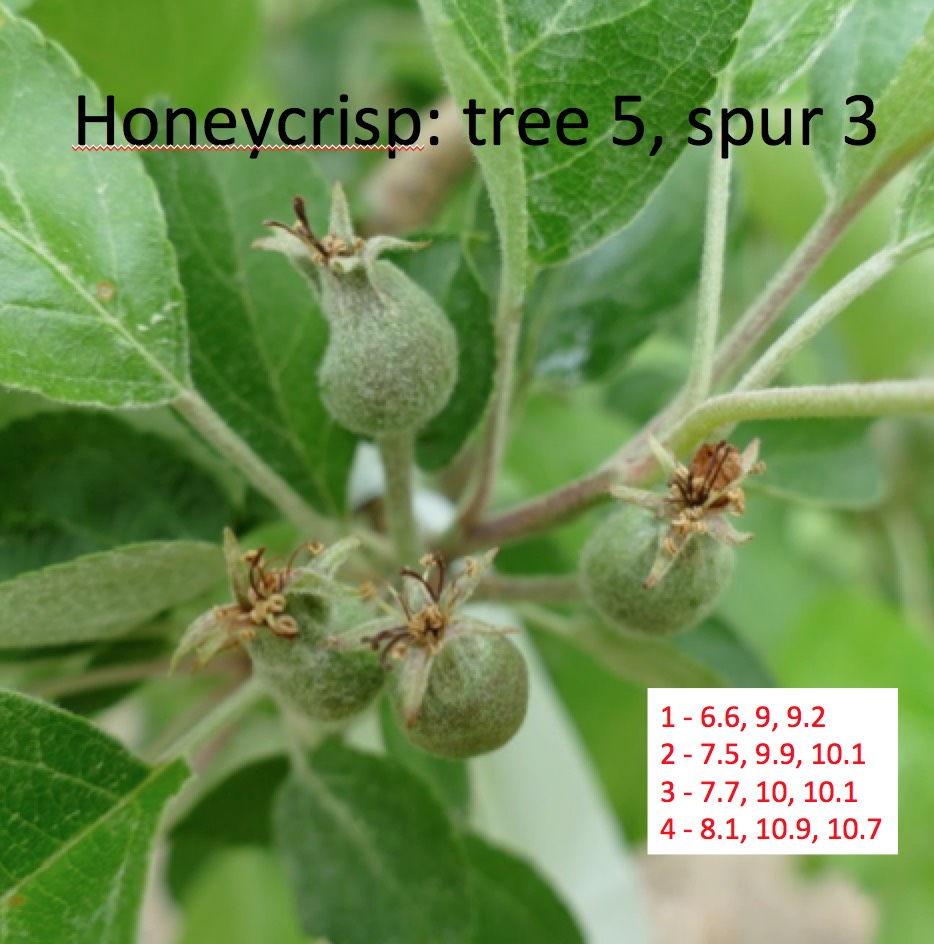
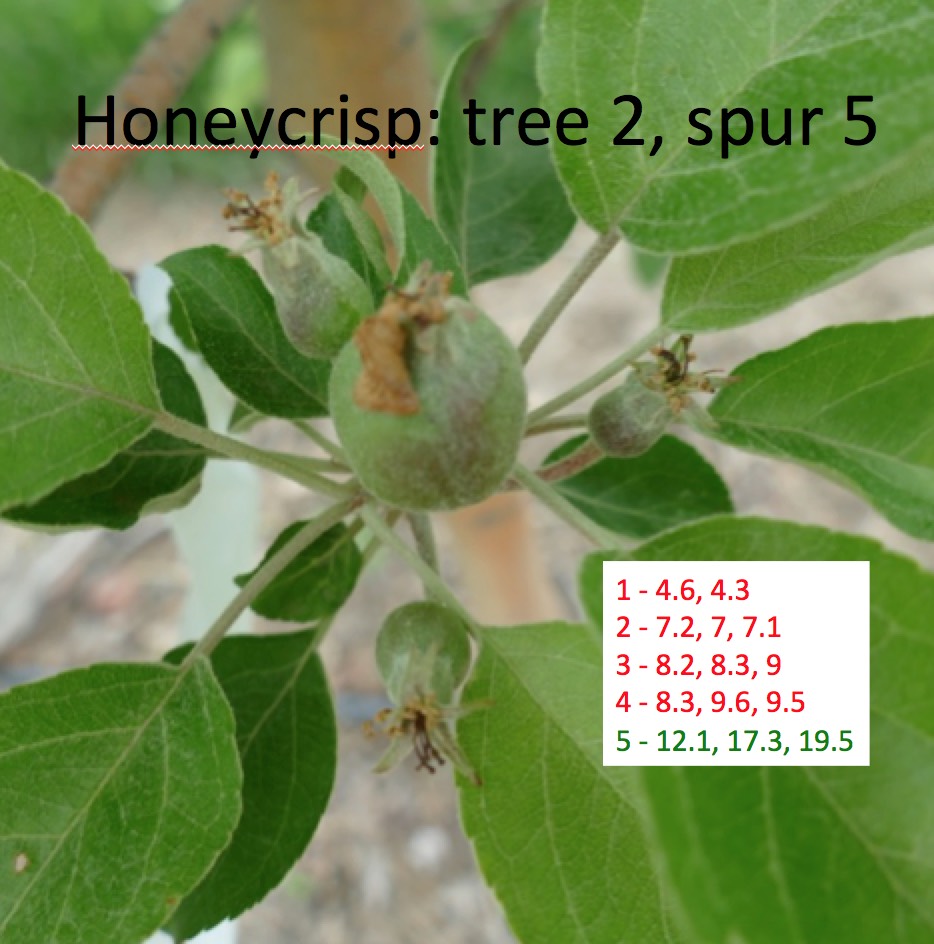
No Guest Article this week. JC
Follow me (jmcextman) on FB: https://www.facebook.com/jmcextman
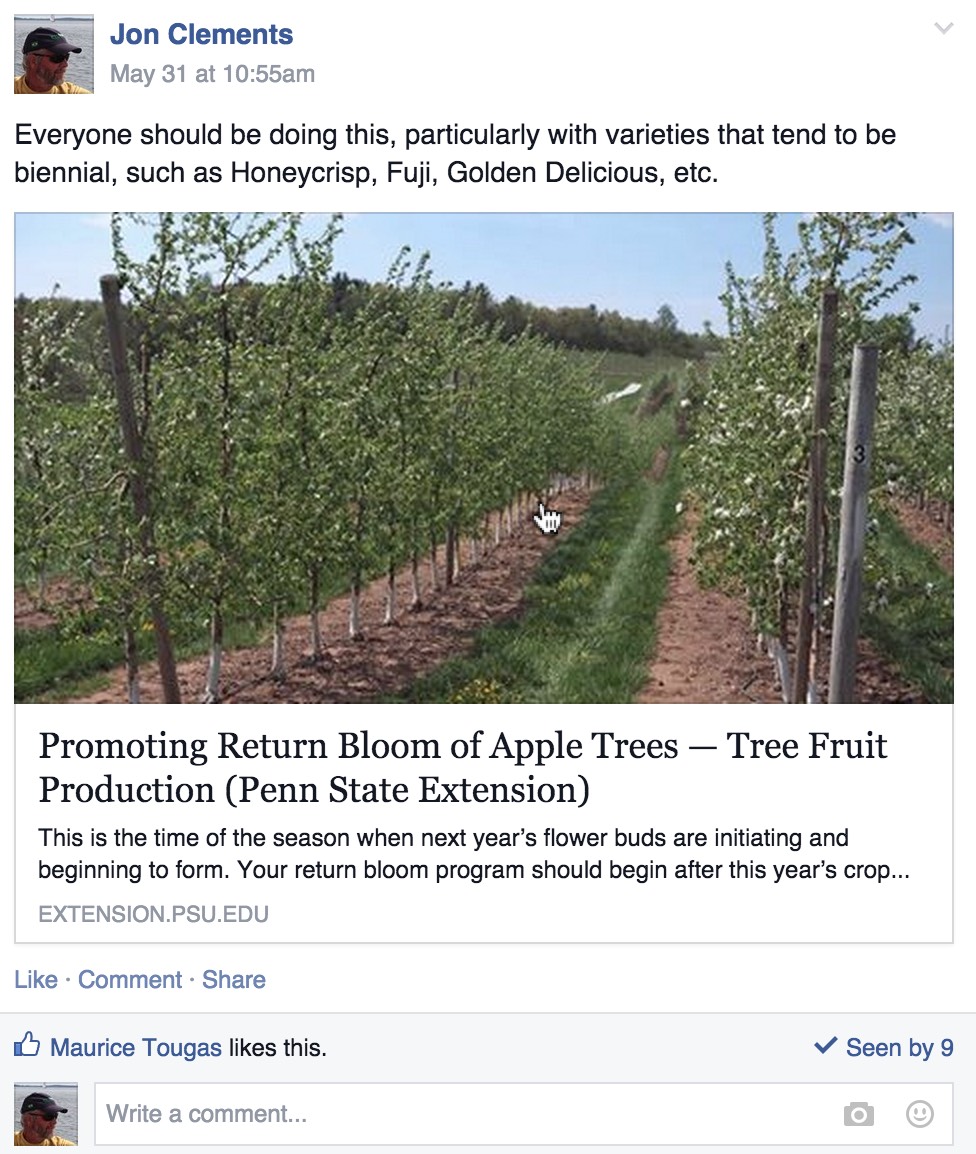
Note: see this article...http://extension.psu.edu/plants/tree-fruit/news/2015/promoting-return-bloom-of-apple-trees
New England Apple Growers Battle Pests with IPM (part 2 of 3)
UMass Fruit Advisor: http://umassfruit.com
Scaffolds Fruit Journal: http://www.nysaes.cornell.edu/ent/scafolds/
Network for Environment and Weather Applications (NEWA): http://newa.cornell.edu
New England Apple Decision Support System maps (experimental)
Follow me on Twitter (http://twitter.com/jmcextman) and Facebook (http://www.facebook.com/jmcextman)
UMass Vegetable & Fruit IPM Network (on Facebook, http://www.facebook.com/umassipmteam)
The next Healthy Fruit will be published on Tuesday, June 9 or thereabouts, 2015. As always feel free to get in touch with any member of the UMass Fruit Team (http://extension.umass.edu/fruitadvisor/team-members) if you have questions or comments.